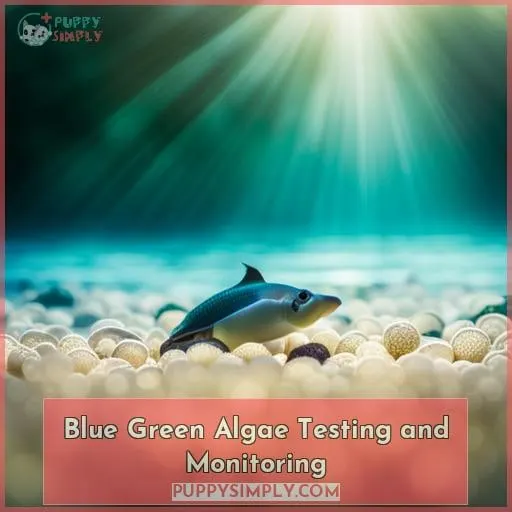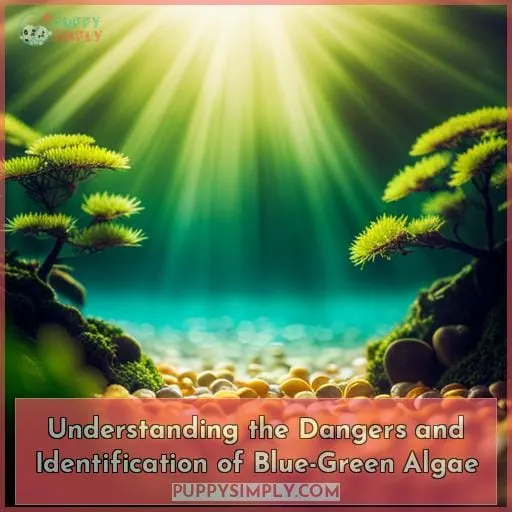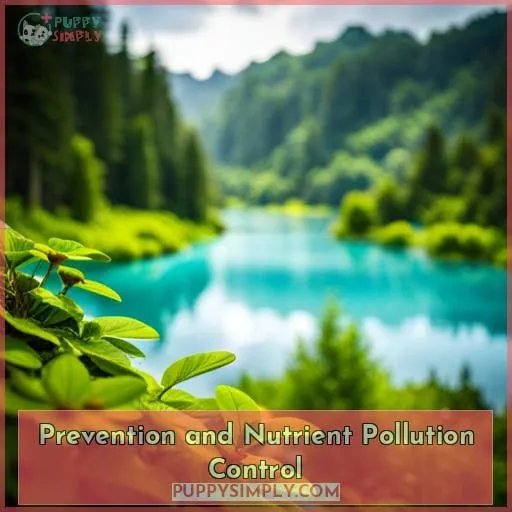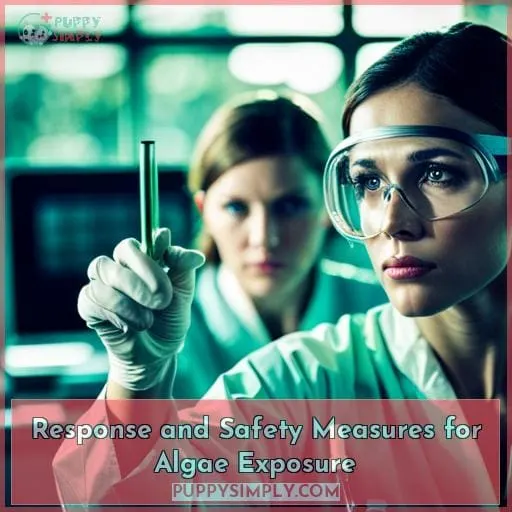This site is supported by our readers. We may earn a commission, at no cost to you, if you purchase through links.
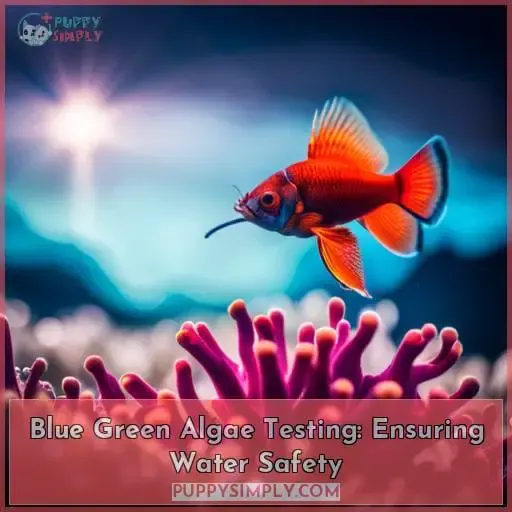 Beginning your journey into understanding blue-green algae testing? You’ve come to the right place. Blue-green algae, also known as cyanobacteria, are a type of photosynthetic bacteria found in both fresh and saltwater environments.
Beginning your journey into understanding blue-green algae testing? You’ve come to the right place. Blue-green algae, also known as cyanobacteria, are a type of photosynthetic bacteria found in both fresh and saltwater environments.
Though they provide numerous benefits to their ecosystems, certain species can produce toxins that make contact with humans dangerous.
Testing for these harmful algal blooms is essential for ensuring safe recreational activities such as swimming or boating. In order to detect potential dangers posed by blue-green algae in lakes or other bodies of water, monitoring must be done regularly.
In Minnesota, this task falls on the Department of Natural Resources (DNR), who checks various areas throughout the state at least twice each summer.
The DNR then communicates any findings through signs posted around monitored locations and on its website so people know when it may not be safe to enter the water due to health concerns from toxic levels of blue-green algae present.
Table Of Contents
Key Takeaways
- Blue-green algae, or cyanobacteria, can produce toxins harmful to humans.
- Testing is essential for safe recreational activities in areas where blue-green algae are present.
- Prevention measures include avoiding algal scums, proper water filtration, and showering after water activities.
- Simple jar tests can be used to identify the presence of blue-green algae.
Blue Green Algae Testing and Monitoring
Testing and monitoring for blue-green algae is an important part of ensuring the safety of our water resources. From IDEM, DNR, IDOH, and BOAH to the Lilly Center at Grace College, sampling from Memorial Day to Labor Day – understanding what toxins are present in a lake is essential for protecting human health as well as livestock and pets.
IDEM, DNR, IDOH, and BOAH’s Role in Monitoring Algae
You can count on IDEM, DNR, IDOH, and BOAH to monitor Indiana water bodies for harmful algae from Memorial Day to Labor Day. They employ various methods, such as sampling and data analysis of nutrient content, to identify the presence of blue-green algae.
Their collaboration efforts also include providing public awareness resources, such as beach advisories or factsheets about health effects due to exposure. Seasonal patterns help inform when cyanotoxins are most likely present in swimming beaches, so people may take caution if needed.
All these steps provide a comprehensive approach to protecting individuals from potentially hazardous algal blooms during the summer months!
Sampling Period and Purpose
From Memorial Day to Labor Day, IDEM, DNR, IDOH, and BOAH take samples of water bodies across Indiana to detect the presence of potentially dangerous cyanobacteria. Sampling periods are determined by seasonal changes in nutrient pollution and algae exposure.
During this time, scientists analyze water samples for toxins that can harm humans or animals through ingestion or skin contact. Beach advisories are also issued by the DNR on signs as well as online resources throughout the season regarding water quality and potential risks from algal blooms.
Identification methods, such as jar tests and stick tests, provide a simple way to determine if blue-green algae is present in a body of water. However, they aren’t foolproof when it comes to toxin levels, so caution should still be used around affected waters regardless of visual observations alone.
Cyanobacteria and Their Occurrence in Water Bodies
Cyanobacteria, commonly known as blue-green algae, are naturally occurring in water bodies and can cause a variety of health risks. They are more likely to be found in nutrient-rich areas with warm surface temperatures.
Cyanotoxins occur when the bacteria form algal scums or blooms on top of the water’s surface. Identification is key for prevention since not all cyanobacteria produce toxins, and exposure levels vary among individuals.
To detect them, consider conducting jar tests or stick tests, which require gloves and careful handling due to potential contact hazards associated with organic matter runoff from shorelines, beaches, and other sources into nearby waterways.
Be aware that some species may settle over time, so regular testing is necessary!
Potential Exposure Through Ingestion or Skin Contact
Inhaling cyanobacteria is less common, but direct contact can irritate your skin like a bee sting.
- Avoid algal scums.
- Shower with warm water and soap after water activities.
- Keep pets and livestock away from affected waters.
- If ill, seek medical attention immediately.
Cyanotoxin risks vary between individuals, so it’s important to be aware of symptoms associated with algae exposure routes. Wearing protective clothing when handling visible algae might reduce the severity of irritation if any occurs.
You can determine whether blue-green algae are present in a body of water before swimming or wading in it through testing methods like jar tests or stick tests.
Understanding the Dangers and Identification of Blue-Green Algae
Blue-green algae blooms are a major concern for lakes and other water bodies as they pose risks to wildlife, pets, and human health. Not only that, but they can also cause aesthetic problems such as unpleasant odors.
Understanding the dangers and identification of blue-green algae is key in order to protect our waters from contamination.
Risks to Wildlife, Pets, and Human Health
You could be at risk of serious illness if you come into contact with blue-green algae, whether through ingestion or skin exposure. Wildlife and pets are especially vulnerable to its toxins; direct contact can cause irritation and poisoning.
Humans may suffer from gastrointestinal distress, nausea, vomiting, liver damage, or even respiratory failure when exposed to cyanobacterial toxins in water bodies affected by an algae bloom.
To reduce the likelihood of these health risks, it is important to avoid ingesting visible algae or coming into direct contact with it while swimming or participating in other activities on the water’s surface.
Aesthetic Problems and Unpleasant Odors in Lakes
Not only can blue-green algae cause health risks, but they can also produce unsightly and smelly blooms that have been known to cover up to 90% of a lake’s surface.
Algal scums are particularly noticeable at public swimming beaches and other recreational areas where visitors come in contact with them directly or through windblown aerosols. To mitigate odors from these blooms, it’s important to reduce nutrient pollution sources such as fertilizer runoff from lawns or septic systems near lakes.
Additionally, increasing public awareness will help people recognize signs of algal blooms so they may be avoided for recreation purposes or treated appropriately if necessary.
Limitations of Identifying Harmful Blue-green Algae by Sight Alone
It can be difficult to recognize dangerous blue-green algae by sight alone. Identification challenges, visual misperceptions, and testing reliability all present problems in determining whether or not a water body is contaminated with toxins.
Additionally, health risks associated with cyanobacteria are often underestimated due to a lack of knowledge about the organisms’ presence in bodies of water. To increase accuracy for identification purposes, smell cues from algal scums should also be taken into account, as well as soil test kits used near public swimming beaches and land disturbance areas where runoff may occur more frequently than in other locations.
Simple and Cost-effective Jar Test for Identification
To get an idea of what’s lurking beneath the surface, try a simple jar test – it’s like opening up a window into algae-infested waters. Put on some gloves and collect water in the jar, three-quarters full. Seal it tight and refrigerate overnight to check for results the next day.
If green paint-like matter floats on top or settles at the bottom, you’ve likely got blue-green algae blooms that can be hazardous to wildlife, pets, and humans alike! Another DIY option is the stick test, but be cautious when assessing water quality using this cost-effective method as harmless species may also float.
Prevention and Nutrient Pollution Control
Nutrient pollution is a significant problem in Indiana’s water bodies, and there are steps you can take to help reduce it. Practices such as using phosphorus-free fertilizer, disposing of grass clippings and leaves properly, inspecting septic systems regularly, and preventing soil runoff are essential for protecting our lakes from nutrient overload.
Practices to Reduce Nutrient Pollution
You can help prevent blue-green algae blooms by taking certain steps to reduce nutrient pollution. Use phosphorus-free lawn fertilizer, check your soil’s nutrient levels before applying garden fertilizer, and don’t fertilize close to waterways.
To avoid nutrient runoff from grass clippings and leaves, regularly inspect and pump out septic systems every two years. Lastly, when engaging in land-disturbing activities, take precautions to stop soil or organic matter from entering nearby water sources.
Proper Fertilizer Use and Disposal
Fertilizing your lawn and garden correctly is an important way to avoid nutrient runoff that can lead to blue-green algae blooms. Did you know that as much as 50% of the phosphorus used in fertilizers ends up running into nearby waterways? To protect water quality, consider using a phosphorus-free fertilizer or testing soil nutrients before application.
Additionally, properly dispose of grass clippings and leaves; keep them out of lakes and streams. Be mindful during land disturbances by preventing any soil or organic matter from entering waterways.
Septic System Maintenance
Regularly checking and pumping out your septic system every two years can help reduce nutrient pollution. This environmental impact helps control the growth of blue-green algae in our waterways, improving the water quality for everyone.
Septic maintenance prevents pollutants from entering rivers and streams, providing a clear habitat for wildlife as well as recreational activities like swimming or fishing. It also reduces the risk of toxic algae blooms that can be dangerous to both humans and animals if ingested or come into contact with the skin.
Taking action is key to preserving Indiana’s natural resources while ensuring public safety through the prevention of harmful algal blooms in our waters!
Preventing Soil and Organic Matter Runoff
Protect your local waterways and take steps to prevent soil and organic matter from washing into them during land-disturbing activities. Properly manage soils by controlling runoff, keeping sediment on site, stabilizing slopes with vegetation or mulch mats, and installing temporary silt fencing.
Be an environmental steward! Fertilize responsibly—check soil nutrient levels before applying garden fertilizer; use phosphorus-free lawn fertilizers; do not fertilize near waterways; follow setbacks for appropriate distances between the water’s edge and application areas.
Dispose of grass clippings and leaves properly to reduce nutrients entering storm drains and surface waters.
Response and Safety Measures for Algae Exposure
Exposure to blue-green algae can be dangerous, so knowing how to identify and respond is crucial. By using simple jar or stick tests and following safety precautions such as avoiding contact with visible algal blooms and showering after water activities, you can protect yourself from harmful exposure.
Ways to Avoid Ingesting or Contacting Visible Algae
Avoid direct contact with visible algae to keep yourself and your loved ones safe. Use gloves when collecting a water sample for testing. The jar test is an easy way to identify blue-green algae. Fill the container up to ¾ and refrigerate overnight. If it resembles paint or emits a sewage smell on day two, it likely contains harmful toxins.
Be aware that some species sink over time, so conduct the stick test too. Insert one into floating mats of green clumps.
Take steps towards preventing nutrient runoff from lawns and gardens near waterways.
Showering or Bathing With Warm, Soapy Water After Water Activities
After a day at the lake, don’t forget to hit the showers – with warm, soapy water, that is! Showering or bathing after swimming in affected waters is an important step for protecting your skin from toxins and preventing any health issues.
Besides showering, though, there are other safety measures you should take:
- Wear protective clothing while in contact with algae-affected waters.
- Avoid drinking contaminated water, even if boiled or treated otherwise, by filtering it before use.
- Rinse off thoroughly using non-chlorinated fresh water when leaving the area of contamination.
- Keep pets out of these areas as well since they can also become exposed to toxins through their fur and paws.
- Check local advisories regularly for updates on potential exposure risks associated with certain bodies of water near you.
For optimal toxin prevention and skin protection, follow these safety measures carefully next time you visit a lake!
Seeking Medical Attention if Illness is Suspected
If you suspect that you have been exposed to harmful algae, it’s important to contact a doctor for medical advice. A medical evaluation can determine if symptoms such as nausea, vomiting, diarrhea, and abdominal pain are related to exposure and provide your physician with the information needed for proper consultation.
If illness suspicion is high due to prolonged or repeated water activities in affected areas, seek healthcare advice immediately as some toxins can cause serious harm when left untreated.
Conclusion
You’ve come a long way, learning about the monitoring and algae information, prevention and nutrient pollution, and dangers and identification of blue-green algae. From IDEM, DNR, IDOH, and BOAH to the Lilly Center at Grace College, there are plenty of resources to ensure water safety.
To check for blue-green algae – a potentially dangerous kind of algae – you can conduct a cost-effective jar or stick test. Of course, it’s important to remember that not all algae is harmful, and it’s not always easy to tell the difference.
Ultimately, blue-green algae testing can help you identify potential risks and prevent exposure to the toxins they may contain.

